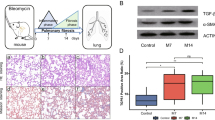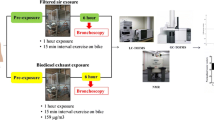Abstract
Acute lung injury (ALI) is a clinically common and serious disease, underscoring the urgent need for clarification of its pathogenesis. According to traditional Chinese medicine (TCM) theories on the “lung–spleen–intestine axis” and its correlation with ALI, a high-performance liquid chromatography–quadrupole time-of-flight mass spectrometry (HPLC–QTOF-MS) metabolomic platform was applied to identify biomarkers from five bio-samples of control and model rats challenged with intratracheally administered lipopolysaccharide (LPS) based on multivariate mathematical statistical analysis. As a result, 19, 24, 24, 15 and 29 altered metabolites were identified in serum, lung, bronchoalveolar lavage fluid (BALF), spleen and feces samples, respectively. Metabolic pathway analysis showed that linoleic acid, sphingolipid, glycerophospholipid and bile acid metabolism pathways were mainly altered by ALI. Additionally, ROC curves were applied to assess the specificity and sensitivity of the biomarkers. ALI characteristic metabolomic spectra were then established to differentiate the control from the model group with a similarity discriminative threshold of 0.7. Additionally, to compare the metabolomic profiles of the five bio-samples and establish metabolic similarities and differences among them, correlation analysis was conducted in order to delineate an objective law of endogenous linkage along the lung–spleen–intestine axis. Therefore, this study provides insights into the mechanisms involved in ALI from a metabolomics perspective, which can be applied in characterization of the mechanism and early disease detection.

Graphical abstract










Similar content being viewed by others
References
Ding H, Ci X, Cheng H, Yu Q, Li D. Chicoric acid alleviates lipopolysaccharide-induced acute lung injury in mice through anti-inflammatory and anti-oxidant activities. Int Immunopharmacol. 2019;66:169–76.
Li K, He Z, Wang X, Pineda M, Chen R, Liu H, et al. Apigenin C-glycosides of Microcos paniculata protects lipopolysaccharide induced apoptosis and inflammation in acute lung injury through TLR4 signaling pathway. Free Radic Biol Med. 2018;124:163–75.
Deng G, He H, Chen Z, OuYang L, Xiao X, Ge J, et al. Lianqinjiedu decoction attenuates LPS-induced inflammation and acute lung injury in rats via TLR4/NF-κB pathway. Biomed Pharmacother. 2017;96:148–52.
Xu PB, Lou JS, Ren Y, Miao CH, Deng XM. Gene expression profiling reveals the defining features of monocytes from septic patients with compensatory anti-inflammatory response syndrome. J Inf Secur. 2012;65:380–91.
Yue X, He J, Zhang R, Xu J, Zhou Z, Zhang R, et al. Biotransformation-based metabolomics profiling method for determining and quantitating cancer-related metabolites. J Chromatogr A. 2018;1580:80–9.
Niziol J, Bonifay V, Ossolinski K, Ossolinski T, Ossolinska A, Sunner J, et al. Metabolomic study of human tissue and urine in clear cell renal carcinoma by LC-HRMS and PLS-DA. Anal Bioanal Chem. 2018;410(16):3859–69.
Shan J, Qian W, Kang A, Peng L, Xie T, Lin L, et al. Lipid profile perturbations in the plasma and lungs of mice with LPS-induced acute lung injury revealed by UHPLC-ESI-Q Exactive HFMS analysis. J Pharm Biomed Anal. 2018;162:242–8.
Nadeem A, Ahmad SF, Al-Harbi NO, Al-Harbi MM, Ibrahim KE, Kundu S, et al. Inhibition of spleen tyrosine kinase signaling protects against acute lung injury through blockade of NADPH oxidase and IL-17A in neutrophils and gamma delta T cells respectively in mice. Int Immunopharmacol. 2019;68:39–47.
Ni J-x, Gao S-h. Understanding the viscera-related theory that the lung and large intestine are exterior-interiorly related. J Tradit Chin Med. 2012;32:293–8.
Hua KY, Qi S, Na H, Ling Z, Yuan ZY, Xin GT, et al. Structural modulation of gut microbiota in rats with allergic bronchial asthma treated with recuperating lung decoction. Biomed Environ Sci. 2016;29(8):574–83.
Al-hazmi A. N-acetylcysteine as a therapeutic extract for cardiac, lung, intestine and spleen injuries induced by microcystin-LR in mice. J King Saud Univ Sci. https://doi.org/10.1016/j.jksus.2019.06.001.
Gao L, Wang J, Li F, Gao S, Deng Y. Analysis on clinically drug-used law for lung-intestine related diseases. J Tradit Chin Med. 2012;32(4):523–8.
van der Does AM, Heijink M, Mayboroda OA, Persson LJ, Aanerud M, Bakke P, et al. Dynamic differences in dietary polyunsaturated fatty acid metabolism in sputum of COPD patients and controls. Biochim Biophys Acta Mol Cell Biol Lipids. 2019;1864(3):224–33.
Evans SJ, Ringrose RN, Harrington GJ, Mancuso P, Burant CF, McInnis MG. Dietary intake and plasma metabolomic analysis of polyunsaturated fatty acids in bipolar subjects reveal dysregulation of linoleic acid metabolism. J Psychiatr Res. 2014;57:58–64.
Das UN. Arachidonic acid and other unsaturated fatty acids and some of their metabolites function as endogenous antimicrobial molecules: a review. J Adv Res. 2018;11:57–66.
Chandrasekharan JA, Marginean A, Sharma-Walia N. An insight into the role of arachidonic acid derived lipid mediators in virus associated pathogenesis and malignancies. Prostaglandins Other Lipid Mediat. 2016;126:46–54.
Huang Y, Chen G, Liu X, Shao Y, Gao P, Xin C, et al. Serum metabolomics study and eicosanoid analysis of childhood atopic dermatitis based on liquid chromatography-mass spectrometry. J Proteome Res. 2014;13(12):5715–23.
Kim KB, Nam YA, Kim HS, Hayes AW, Lee BM. Alpha-Linolenic acid: nutraceutical, pharmacological and toxicological evaluation. Food Chem Toxicol. 2014;70:163–78.
Callejon-Leblic B, Garcia-Barrera T, Gravalos-Guzman J, Pereira-Vega A, Gomez-Ariza JL. Metabolic profiling of potential lung cancer biomarkers using bronchoalveolar lavage fluid and the integrated direct infusion/ gas chromatography mass spectrometry platform. J Proteome. 2016;145:197–206.
Navarrete A, Rupérez FJ, Mendes TO, Pérez-Rial S, Girón-Martínez A, Terrón-Expósito R, et al. A metabolomic approach shows sphingosine 1-phosphate and lysophospholipids as mediators of the therapeutic effect of liver growth factor in emphysema. J Pharm Biomed Anal. 2017;139:238–46.
Zhou X, Wang R, Zhang T, Liu F, Zhang W, Wang G, et al. Identification of lysophosphatidylcholines and sphingolipids as potential biomarkers for acute aortic dissection via serum metabolomics. Eur J Vasc Endovasc Surg. 2019;57(3):434–41.
Lin Z, Sun X, Xie H, Zhang T, Zu X, Qiao L, et al. Plasma metabolomics coupled with MetaboAnalyst and ingenuity pathway analysis characterizes linoleic acid metabolism disorder in patients with spleen-yang-deficiency syndrome. Eur J Integr Med. 2018;19:72–9.
Behr C, Slopianka M, Haake V, Strauss V, Sperber S, Kamp H, et al. Analysis of metabolome changes in the bile acid pool in feces and plasma of antibiotic-treated rats. Toxicol Appl Pharmacol. 2018;363:79–87.
Lin S, Wang TY, Xu HR, Zhang XN, Wang Q, Liu R, et al. A systemic combined nontargeted and targeted LC-MS based metabolomic strategy of plasma and liver on pathology exploration of alpha-naphthylisothiocyanate induced cholestatic liver injury in mice. J Pharm Biomed Anal. 2019;171:180–92.
Fang ZZ, Zhang D, Cao YF, Xie C, Lu D, Sun DX, et al. Irinotecan (CPT-11)-induced elevation of bile acids potentiates suppression of IL-10 expression. Toxicol Appl Pharmacol. 2016;291:21–7.
Funding
This study was supported by the National Natural Science Foundation of China (U1508220); Liaoning Distinguished Professor Project for Qing Li (2017), National Natural Science Funds of China (Grant No. 81973464), Natural Science Foundation of Liaoning Province of China (Grant No.2018010961-301), and Key R&D Program of Liaoning Province (2018226003).
Author information
Authors and Affiliations
Corresponding author
Ethics declarations
Conflict of interest
The authors declare that they have no conflict of interest.
Additional information
Publisher’s note
Springer Nature remains neutral with regard to jurisdictional claims in published maps and institutional affiliations.
Electronic supplementary material
ESM 1
(PDF 2.46 MB)
Rights and permissions
About this article
Cite this article
Wang, T., Lin, S., Liu, R. et al. Metabolomic profile perturbations of serum, lung, bronchoalveolar lavage fluid, spleen and feces in LPS-induced acute lung injury rats based on HPLC-ESI-QTOF-MS. Anal Bioanal Chem 412, 1215–1234 (2020). https://doi.org/10.1007/s00216-019-02357-1
Received:
Revised:
Accepted:
Published:
Issue Date:
DOI: https://doi.org/10.1007/s00216-019-02357-1




